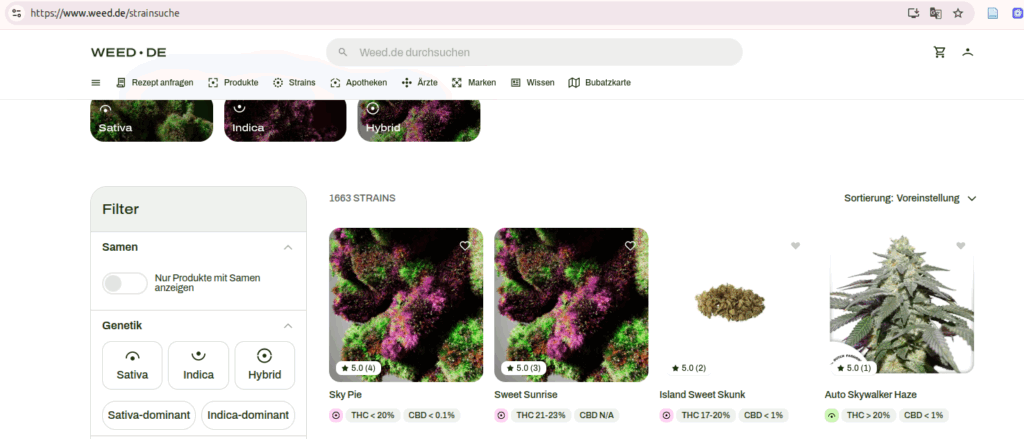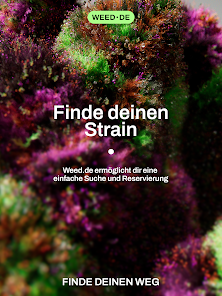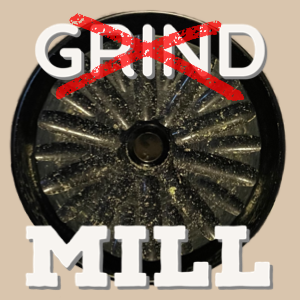Weed.de is THE website to find legal weed in Deutschland
Three years ago, months before descheduling hit German shores in no small part thanks to the hard work of cannabis advocates from the Cannabis Embassy at the United Nations, Justin Hartfield left the American cannabis website WeedMaps to emulate the site’s successes across the pond in the largest European economy with a new website called simply Weed.de.
I got to chat with Hartfield about the website and its goals, Germany’s 18-month old market, genetic diversity and what it means to the consumer, stark comparisons between American and Germany legal cannabis markets, and changes to the cannabis zeitgeist. The neu website, Weed.de, was created to be “the first point of contact for peoples’ first questions about cannabis” – explicitly meant to embrace not shun the “eternal freshman class of people discovering cannabis for the first time.”
Hartfield was frank, he built Weed.de so people seeking to learn about cannabis would have a source to go to that isn’t a government website: A worthy, and laudable goal. Weed.de set out “to be the most trusted and go-to source for all things cannabis in the German market. and to do that, we want to establish more features that are based on the users and their direct needs.” They achieve that continual flow of new features by doing a lot of user surveys and being open to feedback.
Due to the way legalization has rolled out, and the depth of the criminalization and prohibition that came before, this eternal freshman class has much different demographics than the average university. The Canna-curious in Germany come from all ages, ethnicities, genders, and with a wide variety of medical uses they’re seeking – and they all come to the site to be able to find the right flower, with the right chemistry, to provide the desired entourage/ensemble/symphonic effect.
When you’re on Weed.de, you can filter the available cannabis flower cultivars by the presence of terpenes or the amount of THC and/or CBD. A quick look through the 1663 “strains” listed on weed.de as of October 8th, 2025 with a filter for “high CBD >10% CBD” reveals 22 listings. Some of them are just informational listings, some with only seeds of the cultivar available from a local distributor which is perfect for a homegrower, others with flower available to any cannabis prescription holder too. As an example: a high CBD cultivar named Nightingale from WEECO is available at 3.95 euro/gram. I couldn’t do the same on Weedmaps if I wanted to, and trust, I’ve been trying for over a decade.
The high CBD seeds would need to be grown to be verified, but the high CBD flower that is listed there is not just available right now, it’s got multiple layers of government mandated terpene and cannabinoid and contaminant tests to prove its chemical makeup.
If I touched down in Germany tomorrow, I’d check out weed.de and tap that high CBD filter (while keeping an eye out for the THCV filter), and also a few terpene filters, to do the side by side personal experimentation of high CBD, high terpinolene versus high CBD, high beta caryophyllene flower. Weed.de lists the Nightingale as Linalool dominant, I think that deserves to be in the side by side, too.
Still in all jurisdictions whether Cali or Germany or elsewhere, there is the additional risk that overreliance on inherently incomplete testing results may cause unique genetics with terpenes and cannabinoids that are currently untested for to fall by the wayside because of perceived lack of commercial viability.
Once Weed.de starts reporting test results for THCV, or the newly discovered CBDD, I’ll have even more things to look for. If these cannabinoids never show up in Germany because they aren’t required to be tested for or they don’t exist in export countries’ limited repertoire of hybrids, then that is a whole nother can of worms. As a clear example of this, there is a THCV cultivar available in Germany that I was able to find via Weed.de: THCV12. Clearly it has commercial viability, even though government and third party education sources are still catching up as are the mandated testing panels.
To an American that has never been to Germany besides transferring through an airport, this conversation left me with a sharp feeling of a calling to travel and check this out. It’s a feature of the global landscape that I know will certainly have an impact of Post-Prohibition Changes in Cannabis Genetics.
Germany Cannabis Flower Supply Chain Spans the Globe
Not all of the flower available for purchase by prescription holders on Weed.de are grown in Germany – in fact I hear most of it ain’t. There are companies in Germany that are growing their own all within Germany’s borders, while simultaneously importing flower through entirely legal export supply chains – from countries like Australia. Eventually, the economics of shipping indoor grown weed from Australia to Germany will stop making sense, and they’ll be able to provide their German market with German grown weed. This is the on-shoring and domestication of cannabis production happening right before our eyes. Homegrowers in Germany can grow up to three plants – which is three more than I was allowed to grow while living in the allegedly legalized jurisdiction of Nevada. Even in California, many residents are not allowed to grow their supposedly allotted six plants.
All this to say, the way that the government sets the rules as it steps out of Prohibition are very important for determining what kind of market comes as a result – and how diverse that market is.

Germany: the world’s best place for a custie to find cannabis flower diversity?
While Germans may not have access to a diversity in growing styles (good luck finding regenerative sungrown in Germany or any of its feeder medical countries) – they do have unprecedented access to cannabinoid and terpene profiles that are utterly foreign to the average American dispensary.
I anticipate that the sheer volume of cannabinoid and terpene testing that is required over there will push certain terpene profiles to the front of the zeitgeist overseas – in the long run, whether the cannabis zeitgeist on a global level is still being led by California or if there is a new jurisdiction on the rise remains to be seen.
The same way that 1970s California may have been the biggest melting pot for different types of import cannabis from around the world, Germany is now the spot where different flower from different parts of the world can converge and provide a relatively diverse experience to the average German custie. 1970s California was a breeding hotspot. It remains to be seen whether Germany will become a breeding hotspot.
In the 1970s, those imports to California were landraces. In the 2020s, those imports to Germany are almost exclusively of improved hybrids – but there is likely no other modern jurisdiction receiving that many disparate *legal* cannabis flows. I’m holding my breath for when a real imported landrace shows up on German pharmacy shelves – maybe I’m the only one. In fact, I know I’m not the only one because certain Germans and Moroccans alike are already plotting the coming future of legal hashish trade, GMP certified, between the two countries. Even without considering the still-extant traditional hash flows into Germany, legalization has made Germany a destination for legally exported flower from places like Australia and Canada.
In this way, Hartfield reminds me that Germany has “silently taken the crown” for flower in the world. For irradiated indoor flower, sure… but that does still directly translate to a wider range of medical uses of cannabis, the average German patient has it so much better than the average American and yes, even the average Californian and it isn’t just the different regulations causing it, it’s the difference in the level of education that is being put out by the third parties that interface between the market formed by government rules and the new cannabis consumers.
My view is simple: If I can find the chemovar I’m looking for on Weed.de, and I can’t do anything like that using Weedmaps or any of the cannabis resources in California (including my own website), that’s a sign that things are looking up over there.
This is still the first 18 months but under a federally sanctioned system like Germany has, where cannabis companies have full access to banking and no federal scheduling issues to hold things back, we are starting to see hints of what a properly functioning cannabis market might look like. Cannabis with interesting cannabinoid profiles, or terpene profiles are easy to find for consumers, and therefore they’re bred, grown, and bought and their commercial value is recognized
Even with a legal framework that relatively works for helping the eternal class of freshcannabispeoples, there is still a heck of a lot of education that needs to happen. When I asked Weed.de about their role in perpetuating the sativa-indica false dichotomy, Hartfield emphasized that the current Sativa, Indica, and Hybrid categories on the site are provided by the companies themselves, and that educating on pitfalls in that classification system is part of the education done on the blog – and that’s not the only gap that they’ve had to fill in.
The German system isn’t all sunshine and roses for the average cannabis consumer, edibles aren’t sold by pharmacies, for instance – leaving those that prefer edibles to smoking or vaping with a need to learn how to make edibles themselves. Live Rosin on the other hand is beginning to be sold, and is flying off the shelves.
Weed.de noticed this trend in their educational content. Articles on decarbing cannabis for making cannabutter and the best weed brownies in Germany, and other edible recipes are hot.
There’s a clear wave of education, hopefulness, and different types of use emerging and being codified. Justin described: “it’s like California in 2008/2009/2010.” I find the comparison to be so apt. Most people in California consider those years the golden years for everything from price of cannabis to genetic diversity of cannabis. At the same time, we live in a different time. Some users reported wanting AI generated suggestions on what cultivar to try next. The research that backs up those suggestions is slowly but surely happening, and I’m hopeful that some of it will happen in Germany where these test results an education on how to utilize them are more widespread. At the end of the day, test results are a major driver for why people move from the illicit to licit market, but only if the consumer making that decision knows what to look for in the test results.
Where cannabis goes on a worldwide scale, and where in the world is leading cannabis consumption or cultivation is always crucial to formation of the cannabis zeitgeist. A recent report from EKOCAN (text in German) highlights legalization’s impacts over the last 18 months and estimates total cannabis demand including medicinal and recreational use within Germany at “670 to 823 tons.” Recent Department of Cannabis Control estimates of California (legal) cannabis production also fall in the 700 ton range. Things are still very much in flux around the world, but I thoroughly believe that resources such as Weed.de will end up playing a crucial role in stabilizing that flux. One thing is for sure, in the perspective of the global cannabis zeitgeist, we sure are living in interesting times.
Featured image from weed.de.
Founder of The Highest Critic
Unpaid /r/trees mod
Certified Ganjier
Kine bud enthusiast


